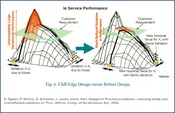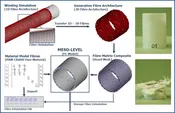Topology Optimization of Structures for Nonlinear Impact Problems

Due to the high non-linearity of impact problems, classic topology optimization methods (e.g. SIMP or homogenization) cannot be applied directly. Therefore, alternative numerical methods are developed here. For this the Equivalent Static Load Method (ESLM), the Ground Structure Approach (GSA) and the Hybrid Cellular Automata (HCA) are extended such that they can be used to derive structures with optimal energy absorption, low mass and high efficiency. [more]
Multi-Fidelity Shape Optimization and Robustness Analysis for Impact

In recent years, Robust Design Optimization became an independent field of research addressing the problem that standard optimization often makes the design more sensitive to unavoidable fluctuations in design and/or noise variables. New approaches are derived here to handle the high complexity and effort especially if robustness is included. Hierarchical and hybrid methods are adapted for application in highly non-linear transient dynamic problems.. [more]
Shape Optimization and Robustness Analysis for Multiphysics

Here, the methods developed for mono- and multi-disciplinary optimization (size and shape) are transferred to multi-physics problems. One focus is the development of highly efficient numerical methods for acoustics and other multi-physics problems coupling numerical simulations in the areas of thermal, fluid and structural systems. Hence algorithms for robustness analysis, sensitivity studies, model reduction, design of experiments and shape variation are combined. [more]
Finite Element Modeling for Biomechanics and Injury Prevention

The methods developed for parametric shape optimization and for robustness analysis are transferred here to establish finite element modeling for biomechanical problems in the area of injury predictions and protection. Special focus is hereby the transition from deterministic studies to stochastic simulations to consider all relevant variabilities. Studies are realized for the head impact of pedestrians onto the bonnet of vehicles and for optimal and robust hip protection design for elderly people. [more]
Multilevel Material Modeling for the Simulation Chain of Composites

Stiffness and strength of fibre reinforced plastics are strongly dependent on the fibre volume content, the fibre architecture and the properties of the matrix. These values are normally derived based on geometrical data obtained via grinding patterns and image analysis, which is very complex and time/cost intensive. Here a more effective, virtual approach is developed, which derives the fibre architecture by numerical simulation of the manufacturing process and hence establishing a multi-level simulation chain. [more]